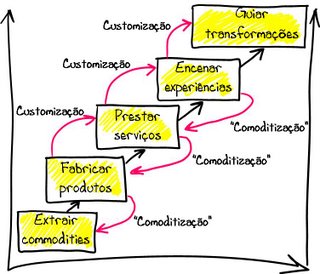A série inicial aqui:
De "Think “input before output”" até "Think “outcome before output”".
Depois, " But they matter only as means to the ends that people seek".
Concentremos a atenção nos outcomes:
"The starting point, clearly, is defining "outcome" in the organization. From our perspective, there are four conditions that jointly determine whether a given outcome is suitable as the basis for a revenue model. First, the outcome must be meaningful-and therefore valuable-to customers. This point is obvious, yet many businesses still fall into the tempting trap of focusing on product or service attributes that they have an inherent interest or competitive advantage in, yet these attributes matter little to those who buy. Claims about meaningful outcomes which are the cornerstones of a firm's value proposition-could be objective or highly subjective, such as "enjoyment" in the case of Teatreneu.
Second, the outcome must be measurable using one or more parameters that are understood and accepted by the organization and its customers. The organization must be able to quantify and express its performance claims in a manner that can form the basis of the exchange with customers. Customers must be able to verify the performance claims. Without these inputs, customers are exposed to possible access, consumption, and performance waste. In business markets, for example, perhaps the most basic outcome is that a particular product or service improves the profitability of customers, either by lowering their costs, increasing their revenue, or a combination of the two. But if profitability cannot be measured directly, then organizations must search for a parameter that can be observed.
...
Third, the measurement of the outcome must be robust, in the sense that the parameter is a faithful representation of the underlying outcome that interests the organization.
...
Finally, the measurement must be reliable, in the sense that neither customers nor a third party can tamper with it. That is, customers should not have the means to "fake" performance level that is not accurate in order to derive a benefit."
Esta abordagem dos "outcomes" fará confusão a muita gente.
Continua.












%2006.21.jpeg)












